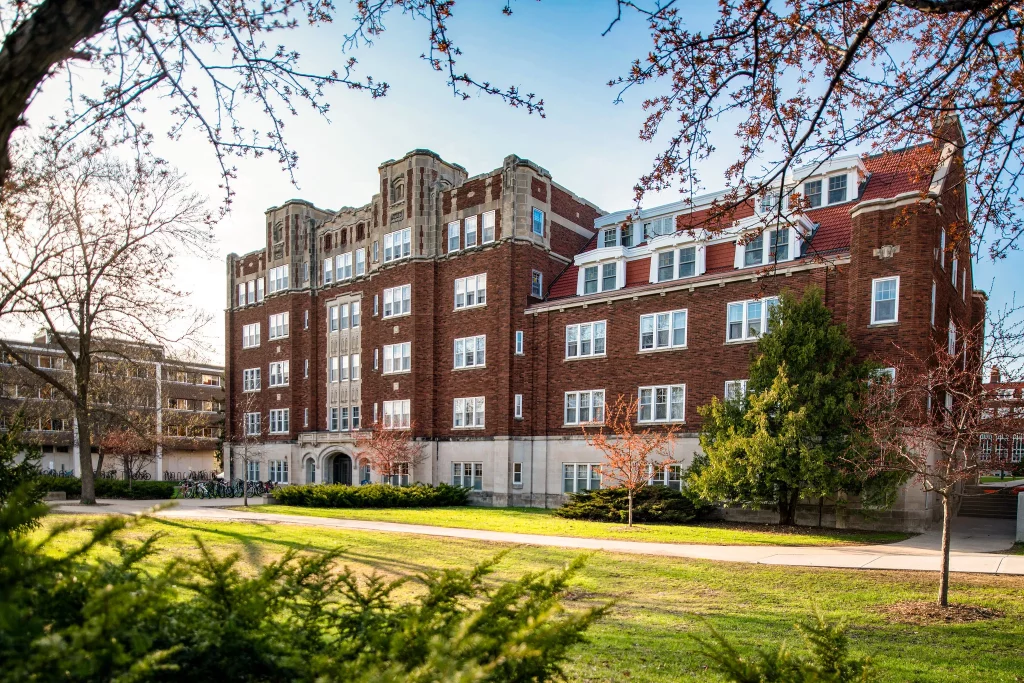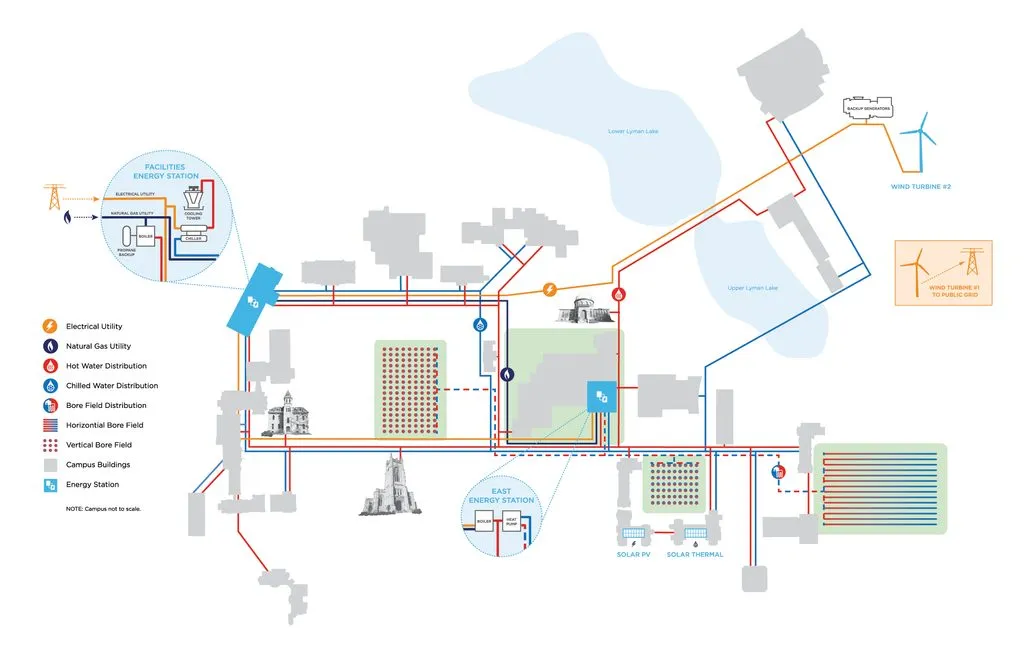Issues and Analyses: Colleges See Untapped Potential In Geothermal District Energy Systems

A spring sunset at Carleton College. Photo: drjoshuawhitman / Creative Commons
by Frank Jossi
This article appeared originally in Energy News Network on February 7, 2022 and is reposted here under Creative Commons License (CC BY-ND 4.0). For more on Amherst College’s efforts to decarbonize the campus through the use of geothermal heat sources look here.
Minnesota’s Carleton College is among a growing list of schools investing in the centuries-old technology as part of a path to eliminating greenhouse gas emissions by 2050 or sooner.
A small but growing list of U.S. colleges and universities are dusting off a centuries-old technology to help meet their ambitious climate goals. Carleton College, a small, private liberal arts college in Northfield, Minnesota, is the latest to trade fossil-fueled steam heat for geothermal district energy as it aims to eliminate greenhouse gas emissions by 2050 or sooner
Completed last summer, the $41 million project is Minnesota’s first geothermal district energy system and one of only about two dozen nationwide. They vary in design but typically consist of a network of pipes and heat pumps that tap into steady, subterranean temperatures to heat and cool buildings on the surface.
Most U.S. geothermal district energy systems were built more than 30 years ago amid rising oil and gas prices in the 1970s and 1980s, but the technology is seeing a resurgence today on college campuses as schools look for tools to help them follow through on climate commitments.
“I think it is one of the only scalable solutions for creating a low-carbon campus,” said Lindsey Olsen, an associate vice president and senior mechanical engineer for Salas O’Brien. The California-based engineering and facility planning firm has worked with Carleton College and others on geothermal projects.
Ancient Technology
Geothermal energy has been used for district heating for over a century in the United States. In Europe, the systems date back to ancient Rome. The oldest still in operation was installed at Chaudes Aigues in France in 1330.
Adoption has been significant in Europe — France, Germany and Iceland are the leaders — but a market has never fully developed in the United States. A 2021 report by the National Renewable Energy Laboratory cited the availability of cheap natural gas, a lack of government incentives, and steep upfront costs as key factors. The U.S. geothermal district heating sector has been “relatively stagnant since the 1980s, with only four new installations over the past two decades,” the report said.
One emerging exception is higher education. “University and college campuses are currently leading the charge in pursuit of low-carbon district energy options as a result of aggressive greenhouse gas emission reduction goals (often 100%) within the next 15 to 30 years,” the report says.
The report lists Carleton College, Princeton University, and Ball State University among the schools installing or expanding geothermal district energy systems. Others include Miami of Ohio, Oberlin, Grinnell, Wheaton, and Amherst colleges.
One of the largest, Princeton’s geothermal system will replace steam generation in more than 180 buildings, some built in the 1700s. Cornell is developing a 10,000-foot-deep “bore hole observatory” where scientists will study strategies for capturing the earth’s heat before installing a geothermal system.

Carleton Project
Carleton has long been a leader on sustainability. In 2004, it became the nation’s first college to build and own a utility wind turbine. A second turbine was added in 2011, the same year the college passed its climate action plan.
Geothermal entered the conversation in 2013 as the school prepared to build a new science center and renovate two existing science buildings. The project would have likely required adding boiler capacity to a 111-year steam plant, according to facilities director Martha Larson.
If the college invested in a gas-fired boiler, the next opportunity to change would not likely emerge for another 50 years, Larson said. The school began working with a Rochester, Minnesota, engineering firm (later acquired by Salas O’Brien), learned about Ball State’s geothermal system, and decided to make an investment in the technology, driven by decarbonization goals.
Carleton’s staff conducted a “layered” analysis involving the cost of well fields and the price of electricity and gas based on different forecasts. Even when considering the worst scenario, the geothermal system broke even in 30 years, she said. Including operations and maintenance, Larson figures the cost difference between steam and hot water will pay back in 20 years.
Construction of geothermal bore fields began in 2017, with crews drilling around 300 under the college’s central quad — known on campus as the “Bald Spot” — and a soccer field over the span of two summers. Contractors sunk bores 520 feet into the earth except on the soccer field, where they employed horizontal drilling to avoid groundwater issues.
Alex Miller, Carleton’s sustainability program coordinator, said the five-year project involved installing more than 60 miles of piping, replacing mechanical equipment and radiators in every building, and building an energy station with an 800-ton heat pump in the basement of the new science building.
Miller’s job during construction was to keep students abreast of what was going on. Messaging had Carleton’s “Carbon Free By 2050” logo. The geology department had students researching the project. The campus held an “End of Steam” event in May 2021 and hired two artists to document the project in what became a 38-minute film.
The school is maintaining a backup system that can supplement geothermal on the coldest and warmest days. The existing steam plant has been retrofitted with new 97% efficient hot water boilers and the existing chillers will remain in place. Unlike the old system, the new one doesn’t require constant staff monitoring. Instead, plant operators work a regular Monday-Friday workweek, reducing maintenance and operations costs by as much as 30%, Larson said.
After the system’s completion, energy use is projected to plummet 40% and emissions by 15%. The campus also has small solar photovoltaic and solar thermal installations that add to the college’s clean energy arsenal. Collectively, Carleton says its emissions have declined 68% since 2008.
Untapped potential
While the U.S. market for geothermal district heating is underdeveloped, the 2021 National Renewable Energy Laboratory report noted “there is vast potential to rapidly deploy GDH [geothermal district heating] in many parts of the United States,” especially as institutions look to decarbonize.
College campuses can be ideal for geothermal applications because they often have existing district energy systems, the space required drilling boreholes into the earth’s surface, a climate action plan, and the patience needed for a return on investment that may take 15 to 20 years.
Rob Thornton, president and CEO of the International District Energy Association, said universities are motivated by carbon-reduction goals and enjoy a longer-term investment horizon than most institutions. Geothermal works in any climate for warming or cooling, Thornton said. New financial instruments, such as green bonds, can help pay for projects, as in the case of Oberlin.
Plenty of roadblocks remain for colleges. They generally have to wait until the time is right and their old steam system nears the end of life to transition to geothermal. Hot water piping must replace steam pipes — an expensive option made more difficult by older buildings and a process that takes years of construction, Thornton said. Converting to geothermal is a significant capital undertaking demanding significant planning and resources. “You can get there, but it takes multiple components,” he said.
Olsen, who after working with Carleton is now overseeing geothermal projects at Amherst, Oberlin, and Princeton, said every project brings surprises that can detour or add expense. For example, when Carleton began drilling boreholes, it found a pressurized aquifer that produced a geyser of water and forced a change in part of the plan, she said.
In speaking to college sustainability leaders about geothermal, Olsen emphasizes that decarbonization involves heating electrification. With electrification comes the ability to incorporate renewable energy. Geothermal combined with heat pump technology is the best technology to achieve electrification, she said. Heat pumps offer the advantage of delivering six times more efficiently than steam gas heating.
Julian Dautremont, program director for the Association for the Advancement of Sustainability in Higher Education, sees more colleges looking at geothermal for individual buildings in addition to district energy solutions. Campuses have begun to focus on ways to heat buildings that reduce carbon emissions and move them away from natural gas and coal-powered systems.
“It’s certainly been slower to take off, like solar or purchased wind, but within the higher ed community we’re seeing quite a bit of attention,” he said of geothermal. “I think it’s poised for growth.”
Frank Jossi is an independent journalist and consultant based in St. Paul and a longtime contributor to Midwest Energy News. His articles have appeared in more than 50 publications, including Minnesota Monthly, Wired, the Los Angeles Times, the Minneapolis Star Tribune, Minnesota Technology, Finance & Commerce and others. Frank has also been a Humphrey policy fellow at the University of Minnesota, a Fulbright journalism teacher in Pakistan and Albania, and a program director of the World Press Institute at Macalester College. Frank covers the state of Minnesota.

2 thoughts on “Issues and Analyses: Colleges See Untapped Potential In Geothermal District Energy Systems”